Related Research Articles

The Abbey of Saint Gall is a dissolved abbey (747–1805) in a Catholic religious complex in the city of St. Gallen in Switzerland. The Carolingian-era monastery has existed since 719 and became an independent principality between 9th and 13th centuries, and was for many centuries one of the chief Benedictine abbeys in Europe. It was founded by Saint Othmar on the spot where Saint Gall had erected his hermitage. The library of the Abbey is one of the oldest monastic libraries in the world. The city of St. Gallen originated as an adjoining settlement of the abbey. Following the secularization of the abbey around 1800, the former Abbey church became a Cathedral in 1848. Since 1983 the abbey precinct has been a UNESCO World Heritage Site.
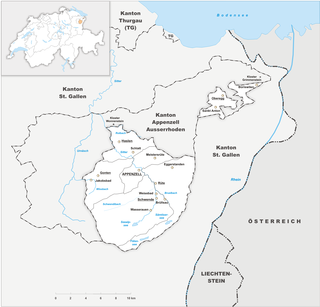
Appenzell Innerrhoden is one of the 26 cantons forming the Swiss Confederation. It is composed of six districts. The seat of the government and parliament is Appenzell. It is traditionally considered a "half-canton", the other half being Appenzell Ausserrhoden.

Appenzell Ausserrhoden is one of the 26 cantons forming the Swiss Confederation. It is composed of twenty municipalities. The seat of the government and parliament is Herisau, and the seat of judicial authorities are in Trogen. It is traditionally considered a "half-canton", the other half being Appenzell Innerrhoden.

Basel was a canton of Switzerland that was in existence between 1501 and 1833, when it was split into the two half-cantons of Basel-City and Basel-Country.

Amlikon-Bissegg is a municipality in the district of Weinfelden in the canton of Thurgau in Switzerland.

Bussnang is a municipality in the district of Weinfelden in the canton of Thurgau in Switzerland.

Gottlieben is a municipality in the district of Kreuzlingen in the canton of Thurgau in Switzerland.
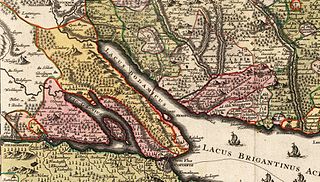
The Prince-Bishopric of Constance, was a small ecclesiastical principality of the Holy Roman Empire from the mid–12th century until its secularisation in 1802–1803. In his dual capacity as prince and as bishop, the prince-bishop was also in charge of the considerably larger Roman Catholic Diocese of Konstanz, which existed from about 585 until its dissolution in 1821. It belonged to the ecclesiastical province of Mainz since 780/782.

Amlikon is a village and former municipality in the canton of Thurgau, Switzerland.

Bissegg is a village and former municipality in the canton of Thurgau, Switzerland.

Bichelsee is a village and former municipality in the canton of Thurgau, Switzerland. It takes its name from the nearby lake, Bichelsee.
Strohwilen is a village and former municipality in the canton of Thurgau, Switzerland.
Fimmelsberg is a village in the canton of Thurgau, Switzerland.
Holzhäusern is a village in the canton of Thurgau, Switzerland.

Söflingen Abbey was a nunnery of the Order of Poor Ladies, also known as the Poor Clares, the Poor Clare Sisters, the Clarisse, the Minoresses, or the Second Order of St. Francis. It was situated in the village of Söflingen, now part of Ulm in Baden-Württemberg, Germany. Being the oldest nunnery of this order in Germany, it was also its most important and most affluent.
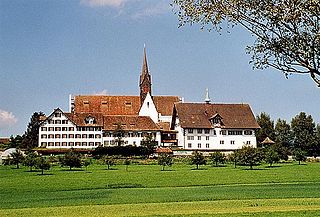
Kappel Abbey is a former Cistercian monks monastery located in Kappel am Albis in the Swiss canton of Zurich.

Münchenwiler Castle or Château de Villars-les-Moines is a castle and former Cluniac priory in the municipality of Münchenwiler of the Canton of Bern in Switzerland. It is a Swiss heritage site of national significance.
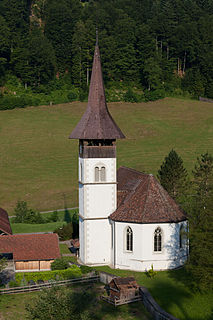
Trub Abbey is a former Benedictine monastery in the municipality of Trub in Bern Switzerland
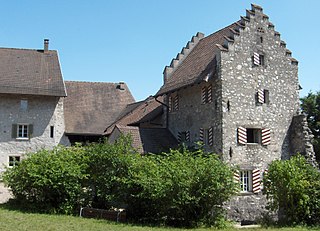
Altenburg Castle is a castle in the village of Altenburg bei Brugg in the municipality of Brugg in the canton of Aargau in Switzerland. The castle and the Altenburg Roman ruins, which are integrated into it, are classified as Swiss heritage site of national significance.

Thurnen is a municipality in the Bern-Mittelland administrative district in the canton of Bern in Switzerland. On 1 January 2020 the former municipalities of Kirchenthurnen, Lohnstorf and Mühlethurnen merged to form the new municipality of Thurnen.
References
- ↑ Amtliches Gemeindeverzeichnis der Schweiz published by the Swiss Federal Statistical Office (in German) accessed 14 January 2010
- 1 2 Griesenberg in German , French and Italian in the online Historical Dictionary of Switzerland .
- Griesenberg in German , French and Italian in the online Historical Dictionary of Switzerland .
Coordinates: 47°34′8″N9°0′42″E / 47.56889°N 9.01167°E